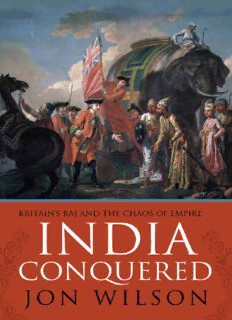
India Conquered: Britain’s Raj and the Chaos of Empire PDF
Preview India Conquered: Britain’s Raj and the Chaos of Empire
‘The total character of the world is . . . in all eternity chaos.’ Friedrich Nietzsche, The Gay Science ‘Power cannot be made secure only against power, it also must be made secure against the weak; for there lies the peril of its losing balance.’ Rabindranath Tagore, ‘A Cry for Peace’ for Delilah and Elsie CONTENTS Preface: Facts on the Ground 1. Society of Societies 2. Trading with Ghosts 3. Forgotten Wars 4. Passion at Plassey 5. New Systems 6. Theatres of Anarchy 7. The Idea of Empire 8. Fear and Trembling 9. The Making of Modern India 10. The Legalization of India 11. The Great Depression 12. Governments within Governments 13. Military Imperialism and the Indian Crowd 14. Cycles of Violence 15. The Great Delusion List of Illustrations Notes Bibliography Acknowledgements Preface FACTS ON THE GROUND W hile turning Bombay’s home for old European sailors into a legislative assembly in January 1928, labourers came across patches of red dust. The dust was the disintegrated remains of the city’s first English residents. Now 200 metres inland, workers had dug into a graveyard that once stood on the desolate promontory of Mendham’s Point, looking out over crashing waves and shipwrecks. There, senior English officers had been buried in elaborate tombs, but the bones of clerks and soldiers, the ordinary English functionaries of empire, were thrown in a shallow grave under a big slab of stone. Corpses were quickly dug out by jackals ‘burrowing in the ground like rabbits’, according to one account. Even the clergy were buried in common graves, with Bombay’s first five priests thrown together in one hole. The cemetery was ‘more terrible to a sick Bombaian than the Inquisition to a heretic’, one observer wrote. By 1928, the cemetery had been entirely forgotten.1 The English ruled territory in India from the 1650s. Britain was the supreme political force in the subcontinent that stretches from Iran to Thailand, from the Himalayas to the sea, from at least 1800 until 1947. These years of conquest and empire left remains that survived in South Asia’s soil, sometimes until today. Perhaps a quarter of a million Europeans are still buried in more than a thousand ‘cities of the dead’, as the British explorer Richard Burton called them in 1847, scattered through the countries that once made up British-ruled India – India, Bangladesh, Pakistan and Burma. These graves trace the geography of British power during those years, marking the processes and places from which imperial authority was asserted. The earliest are in ports and forts like Bombay, Calcutta and Madras. There, tiny groups of British merchants sheltered behind thick stone walls, with white- skinned soldiers and gunners to protect them from people they tried to make money from. The largest numbers are close to British-built courts and tax offices, near blocky churches built quickly by army engineers as Britain’s conquests extended power through every part of India in the early nineteenth century. Some, like the graves every few miles on India’s grand trunk road between Calcutta and Delhi, are by highways, marking the death of Europeans travelling or laying roads. Others, like the hilltop cemetery at Khandala three hours’ train ride from Bombay, cling to slopes above railway tunnels built at the expense of many Indian and a few European lives, as the British asserted their power by cutting lines of steel into Indian soil from the late nineteenth century on. From the early 1800s the largest single group of graves were those of children, ‘little angels’, as the tombstones often described them, killed by disease in their first years before they could be shipped back to Britain to boarding school. One hundred and fifty-one of the nearly 400 gravestones in the cantonment town of Bellary marked the death of children under the age of seven. All these graves mark the death of Britons who intended to return home.2 There is little sense of imperial celebration in the inscriptions on these gravestones. More often, the words on tombs convey a sense of distance and failure. Epitaphs describe men and women retreating into small worlds cut off from Indian society who died unhappily distant from their homes. Very few mention any connection to the people they ruled. What mattered was their sense of private virtue and the esteem of British friends and family, close by or thousands of miles back in Britain or Ireland. Shearman Bird, dead in Chittagong at forty-one, ‘was a bright example of duty, affection, strength of principle and unshakeable fidelity’, his gravestone says. ‘His converse with this world contaminated not his genuine worth.’ Richard Becher, dead at Calcutta in 1782, was buried ‘[u]nder the pang of disappointment / and the pressure of the climate’. Graves like Bird’s and Becher’s were not those of a triumphant race, but the tombstones of ‘a people scattered by their wars and affairs over the face of the whole earth, and homesick to a man’, as the American Ralph Waldo Emerson wrote of the English.3 There are 1,349 recorded British graveyards in South Asia. Now they are quiet and still, the only signs of life coming from the visits of grass cutters or tourists. But other imperial remains in modern South Asia are full of activity.4 South Asia’s independent states have moved into the institutions of British rule, many close to the centres of present-day public power. The architecture of old Indian city centres usually conforms roughly to imperial plans, with sites of administration standing aloof from the centres of commercial activity, in quiet,
Description: